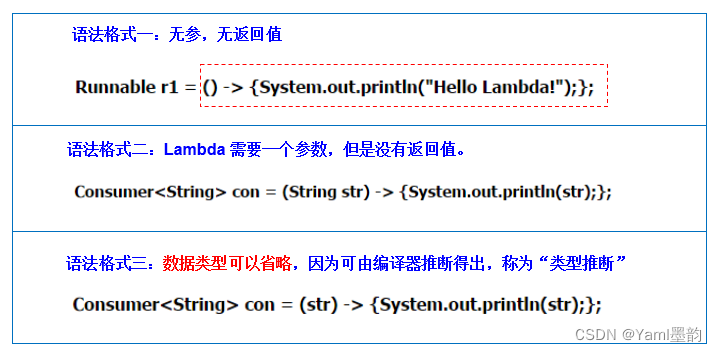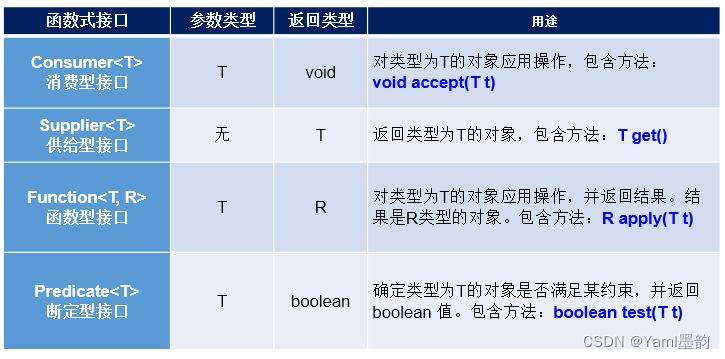目录
一、Lambda
1、什么是Lambda表达式
2.Lambda表达式的基本语法:
3.参数列表
4.Lambda表达式使用前后对比
举例一:
举例二:
二、函数式接口
1.函数式接口的使用说明
2.4个基本的函数式接口
3.如何定义函数接口
1.保证接口中只能有一个抽象方法
2.使用@FunctionalInterface注解标记该接口为函数接口
4.Lambda表达式调用方式
1.使用Lambda调用无参函数
2.使用Lambda调用有参函数
3.使用Lambda的精简写法
4.使用Lambda实现集合遍历
5.使用Lambda实现集合排序
6.使用Lambda实现线程调用
一、Lambda
1、什么是Lambda表达式
Lambda 表达式是 Java 8 引入的一种新的语法特性,它可以使得代码更加简洁、易读,并且支持函数式编程。Lambda 表达式实际上就是一个匿名方法,它可以作为参数传递给方法或者存储在变量中。
2.Lambda表达式的基本语法:
* 1.举例: (o1,o2) -> Integer.compare(o1,o2);
* 2.格式:
* -> :lambda操作符 或 箭头操作符
* ->左边:lambda形参列表 (其实就是接口中的抽象方法的形参列表
* ->右边:lambda体 (其实就是重写的抽象方法的方法体
3.参数列表


4.Lambda表达式使用前后对比
举例一:
@Test
public void test1(){Runnable r1 = new Runnable() {@Overridepublic void run() {System.out.println("我爱北京天安门");}};r1.run();System.out.println("***********************");Runnable r2 = () -> System.out.println("我爱北京故宫");r2.run();
}举例二:
@Test
public void test2(){Comparator<Integer> com1 = new Comparator<Integer>() {@Overridepublic int compare(Integer o1, Integer o2) {return Integer.compare(o1,o2);}};int compare1 = com1.compare(12,21);System.out.println(compare1);System.out.println("***********************");//Lambda表达式的写法Comparator<Integer> com2 = (o1,o2) -> Integer.compare(o1,o2);int compare2 = com2.compare(32,21);System.out.println(compare2);System.out.println("***********************");//方法引用Comparator<Integer> com3 = Integer :: compare;int compare3 = com3.compare(32,21);System.out.println(compare3);
}二、函数式接口
1.函数式接口的使用说明
如果一个接口中,只声明了一个抽象方法,则此接口就称为函数式接口。
我们可以在一个接口上使用 @FunctionalInterface 注解,这样做可以检查它是否是一个函数式接口。
Lambda 表达式的函数体可以是一个表达式,也可以是一个语句块。如果函数体只有一条表达式,可以直接写在箭头后面;如果函数体包含多条语句,需要使用大括号
{}将它们括起来,并使用分号;分隔。Lambda表达式的本质:作为函数式接口的实例
2.4个基本的函数式接口
Java8中关于Lambda表达式提供的4个基本的函数式接口:具体使用:

3.如何定义函数接口
定义一个函数接口需要满足以下两点:
1.保证接口中只能有一个抽象方法
2.使用@FunctionalInterface注解标记该接口为函数接口
@FunctionalInterface
public interface MyInterfaceByJava8 {void add();//只能存在一个抽象方法
}4.Lambda表达式调用方式
1.使用Lambda调用无参函数
首先定义一个函数接口
@FunctionalInterface
public interface FuncInterface {void add();
}接着实现并调用这个无参函数,这里展示传统的匿名内部类调用法,跟Lambda调用法。
public static void main(String [] args){//使用匿名内部类调用new FuncInterface(){@Overridepublic void add() {System.out.println("匿名内部类实现调用");}}.add();//使用Lambda调用((FuncInterface)()->{System.out.println("Lambda实现调用");}).add();}可以看到使用Lambda代码更加简洁优雅
2.使用Lambda调用有参函数
定义函数接口
@FunctionalInterface
public interface FuncInterface2 {int del(int id);
}实现并调用
public static void main(String [] args){int id=101;//使用匿名内部类调用int result1=new FuncInterface2(){@Overridepublic int del(int id) {System.out.println("匿名内部类实现调用:"+id);return 1;}}.del(id);//使用Lambda调用int result2=((FuncInterface2)(p)->{System.out.println("Lambda实现调用:"+p);return 1;}).del(id);System.out.println(result1);System.out.println(result2);}3.使用Lambda的精简写法
当函数参数仅有一个时可以省略括号(没有参数时必须用空括号,不能省)
//普通写法
int result2=((FuncInterface2)(p)->{System.out.println("Lambda实现调用:"+p);return 1;}).del(id);//精简写法--省略参数园括号
int result2=((FuncInterface2)p->{System.out.println("Lambda实现调用:"+p);return 1;}).del(id);当函数体只有一条语句可以省略{}
//普通写法
((FuncInterface)()->{System.out.println("Lambda实现调用");}).add();//精简写法--省略函数体括号
((FuncInterface)()->System.out.println("Lambda实现调用")).add();当函数体仅有一条语句且是返回语句时,可以省略return
//普通写法
int result2=((FuncInterface2)p->return 1).del(id);//精简写法--省略return
int result2=((FuncInterface2)p->1).del(id);4.使用Lambda实现集合遍历
public static void main(String [] args){List<String> names=Arrays.asList("小明","小黑","小红");//传统遍历--增强forfor(String name:names){System.out.println(name);}//传统遍历--匿名内部类names.forEach(new Consumer<String>(){@Overridepublic void accept(String name) {System.out.println(name);}});//Lambda表达式遍历names.forEach(name->System.out.println(name));
}5.使用Lambda实现集合排序
将学生集合的学生按照年龄排序
public static void main(String [] args){List<Student> students1=Arrays.asList(new Student("小明",18),new Student("小黑",16),new Student("小红",17));List<Student> students2=Arrays.asList(new Student("小明",18),new Student("小黑",16),new Student("小红",17));//传统排序--匿名内部类students1.sort(new Comparator<Student>(){@Overridepublic int compare(Student stu1, Student stu2) {return stu1.getAge()- stu2.getAge();}});//Lambdastudents2.sort((stu1,stu2)->stu1.getAge()-stu2.getAge());//省略returnSystem.out.println(students1);System.out.println(students2);
}6.使用Lambda实现线程调用
public static void main(String [] args){//传统调用new Thread(new Runnable(){@Overridepublic void run() {System.out.println("子线程运行了");}}).start();//Lambdanew Thread(()->System.out.println("子线程运行了")).start();
}


)








需要把selinux设置为Permissive宽容模式)

-ControlNet(Tile/Blur))



)
